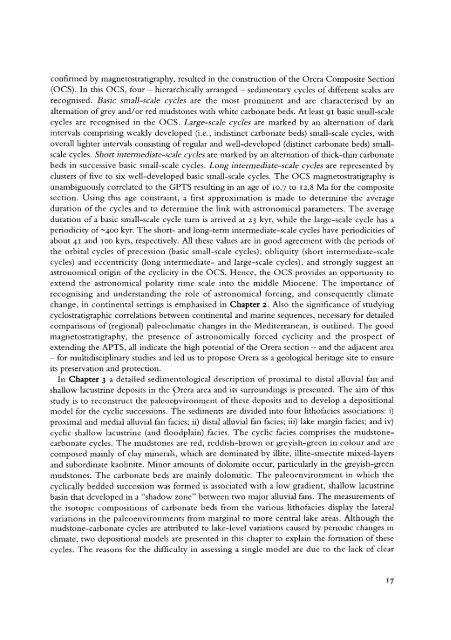The Orera section (Calatayud Basin, NE Spain) - Universiteit Utrecht
The Orera section (Calatayud Basin, NE Spain) - Universiteit Utrecht
The Orera section (Calatayud Basin, NE Spain) - Universiteit Utrecht
Create successful ePaper yourself
Turn your PDF publications into a flip-book with our unique Google optimized e-Paper software.
confirmed by magnetostratigraphy, resulted in the construction ofthe <strong>Orera</strong> Composite Section<br />
(OCS). In this OCS, four - hierarchically arranged - sedimentary cycles of different scales are<br />
recognised. Basic small-scale cycles are the most prominent and are characterised by an<br />
alternation ofgrey and/or red mudstones with white carbonate beds. At least 91 basic small-scale<br />
cycles are recognised in the OCS. Large-scale cycles are marked by an alternation of dark<br />
intervals comprising weakly developed (i.e., indistinct carbonate beds) small-scale cycles, with<br />
overall lighter intervals consisting ofregular and well-developed (distinct carbonate beds) smallscale<br />
cycles. Short intemlediate-scale cycles are marked by an alternation ofthick-thin carbonate<br />
beds in successive basic small-scale cycles. Long intermediate-scale cycles are represented by<br />
clusters of five to six well-developed basic small-scale cycles. <strong>The</strong> OCS magnetostratigraphy is<br />
unambiguously correlated to the GPTS resulting in an age of ro.7 to 12.8 Ma for the composite<br />
<strong>section</strong>. Using this age constraint, a first approximation is made to determine the average<br />
duration of the cycles and to determine the link with astronomical parameters. <strong>The</strong> average<br />
duration of a basic small-scale cycle turn is arrived at 23 kyr, while the large-scale cycle has a<br />
periodicity of-400 kyr. <strong>The</strong> short- and long-term intermediate-scale cycles have periodicities of<br />
about 41 and roo kyrs, respectively. All these values are in good agreement with the periods of<br />
the orbital cycles of precession (basic small-scale cycles), obliquity (short intermediate-scale<br />
cycles) and eccentricity (long intermediate- and large-scale cycles), and strongly suggest an<br />
astronomical origin of the cyclicity in the OCS. Hence, the OCS provides an opportunity to<br />
extend the astronomical polarity time scale into the middle Miocene. <strong>The</strong> importance of<br />
recognising and understanding the role of astronomical forcing, and consequently climate<br />
change, in continental settings is emphasised in Chapter 2. Also the significance of studying<br />
cyclostratigraphic correlations between continental and marine sequences, necessary for detailed<br />
comparisons of (regional) paleoclimatic changes in the Mediterranean, is outlined. <strong>The</strong> good<br />
magnetostratigraphy, the presence of astronomically forced cyclicity and the prospect of<br />
extending the APTS, all indicate the high potential of the <strong>Orera</strong> <strong>section</strong> - and the adjacent area<br />
- for multidisciplinary studies and led us to propose <strong>Orera</strong> as a geological heritage site to ensure<br />
its preservation and protection.<br />
In Chapter 3 a detailed sedimentological description of proximal to distal alluvial fan and<br />
shallow lacustrine deposits in the prera area and its surroundings is presented. <strong>The</strong> aim of this<br />
study is to reconstruct the paleoeuvironment of these deposits and to develop a depositional<br />
model for the cyclic successions. the sediments are divided into four lithofacies associations: i)<br />
proximal and medial alluvial fan facies; ii) distal alluvial fan facies; iii) lake margin facies; and iv)<br />
cyclic shallow lacustrine (and floodplain) facies. <strong>The</strong> cyclic facies comprises the mudstonecarbonate<br />
cycles. <strong>The</strong> mudstones are red, reddish-brown or greyish-green in colour and are<br />
composed mainly of clay minerals, which are dominated by illite, illite-smectite mixed-layers<br />
and subordinate kaolinite. Minor amounts of dolomite occur, particularly in the greyish-green<br />
mudstones. <strong>The</strong> carbonate beds are mainly dolomitic. <strong>The</strong> paleoenvironment in which the<br />
cyclically bedded succession was formed is associated with a low gradient, shallow lacustrine<br />
basin that developed in a "shadow zone" between two major alluvial fans. <strong>The</strong> measurements of<br />
the isotopic compositions of carbonate beds from the various lithofacies display the lateral<br />
variations in the paleoenvironments from marginal to more central lake areas. Although the<br />
mudstone-carbonate cycles are attributed to lake-level variations caused by penodlc changes in<br />
climate, two depositional models are presented in this chapter to explain the formation ofthese<br />
cycles. <strong>The</strong> reasons for the difficulty in assessing a single model are due to the lack of clear<br />
17

















